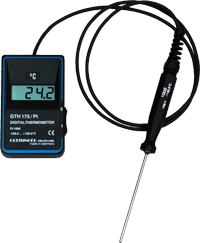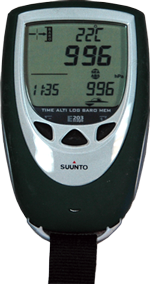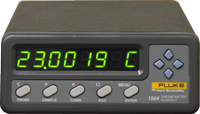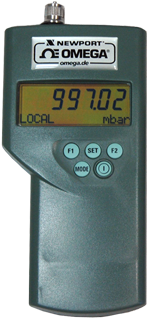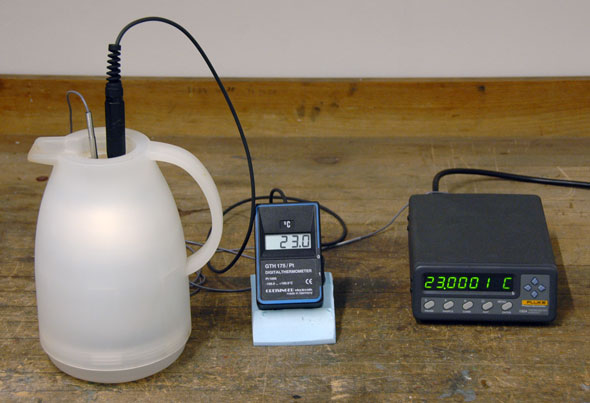For absolute dose measurements, many dosimetry protocols require an estimation of uncertainties. Without at least some basic kind of error analysis, stated measurement results are considered incomplete.
Let's assume you are a clever medical physicist and want to improve your overall measurement accuracy by using a precision thermometer and barometer. It is well known that temperature T and pressure p will both influence the reading of an ionization chamber: if air temperature is higher than reference, air density will be lower, so the reading will be too low. The higher the pressure, the higher the density and the reading. If T and p are known, the air density correction factor kdens
can be calculated. Here, T (in K) and p (in hPa) are the absolute temperature and pressure at the measuring point, p0 = 1013.25 hPa, T0 = 293.15 K are the reference values.
There are many other correction factors in ionisation chamber dosimetry, but for now we will set them all to unity and ignore their uncertainties. The only other factor we will include in our analysis is the 60Co chamber calibration factor (NW) which we get from our accredited calibration laboratory (see our Roos, 0.3 cm3, Farmer, or waterproof Farmer chambers for some examples).
This is our simplified formula for calculating the dose in water from the raw dosemeter reading M:
The question now is: would a reduced uncertainty in T and p improve our overall dose accuracy?
Fig.1: Cross-calibration in our home-made sand-bath (I think we can say that the two readings are identical ...)
Our equipment
Each linac has its own "field" thermometer and barometer. The readings of these devices are compared to the readings of our precision instruments twice a year (thermometer and barometer QA). Fig.1 shows the comparison process for the thermometer. The home-made "temperature bath", which is also used for cross-calibration, is filled with sand.
Comparing the barometers is even easier - just put them side by side at the same height!
The manual of the GTH thermometer states the accuracy as "± 0.1% of meas. value ± 2 digit (at nom. temperature)". This equals an absolute uncertainty of 0.3° + 0.2° = 0.5°C at 297 K (our standard linac room temperature is 24°C). Let's convert this back to a single value for the relative uncertainty, which gives ±0.5/297 or ±0.17%. This is the same relative standard uncertainty that the Austrian dosimetry standard S5234-3 mentions for typical uncertainties of good thermometers.
The precision counterpart of the GTH is the Hart Scientific 1504 (with 5610 Thermistor Probe). The typical accuracy of the system is ±0.005°C. The relative accuracy at 24°C therefore is ±0.005/297 = ±0.0017%.
The accuracy of the Suunto E203 is not known. Let's assume it is ±0.1%, which equals ±1 hPa.
The precision counterpart to the Hart is the Omega DPI740 pressure indicator (pressure range: 750 to 1150 hPa). With its "enhanced barometric accuracy option", the accuracy is ±0.15 hPa (full scale) in the temperature range of 10° to 30°C. The relative uncertainty therefore is ±0.01%.
Calculating the uncertainty in kdens
The air density correction factor kdens (1) has two input quantities: T and p. A general rule for finding the uncertainties in products and quotients like
is that if the uncertainties of the input quantities are independent and random, then the fractional uncertainty in q is the sum in quadrature of the original fractional uncertainties,
(See Taylor, Section 3.6)
Now (1) has definitely the form of (3). For the calculation of the uncertainty in kdens - according to (4) - it makes no difference whether T and p are in the numerator or the denominator.
The calculation of the relative uncertainties of kfield for the standard and kprecision for the precision instruments is straightforward:
Equation (6) tells us a lot about combining uncertainties of different magnitude. If one contribution is much larger than the other, it will dominate the result.
Adding Nw to the story
The 60Co chamber calibration factor NW has an expanded uncertainty of typically 0.014 (or 1.4%) with the coverage factor k=2. This means that before we can combine the uncertainty of NW with the uncertainty of kdens, we have to divide the former by 2.
The reading M of the electrometer and its uncertainty are ignored here but are of course equal important. Random errors suggest repeating the measurement several times. We assume "an infinite number of measurements" or whatever miracle is needed to reduce M's uncertainty to zero.
From the magnitude of NW's uncertainty (0.7% with k=1), you can already guess the result of our analysis:
In other words: It is not worth using precision instruments for T and p, because NW's uncertainty dominates the sum in quadrature. In (8), the difference of the two terms under the square root is so large that we could have used an "equals" sign as well.
And this is not the end of the story: the uncertainty of the beam quality correction factor, kQ for photons, kE for electrons, is even larger: it is around 1% for photons and 1.2% or 1.3% for electrons (depending on chamber type). This and possibly other uncertainties (like NW's potential drift over time) are larger than that of kdens.
The main message therefore is: To reduce the overall uncertainty, the dominating factor has to be adressed.
Note: Already the system accuracy of the Hart is a combination: according to specs, the readout has a typical accuracy of ±0.002°C, the thermistor has ±0.01°C (with k=2). The latter term, as we have learned, dominates the overall accuracy of the Hart thermometer.
